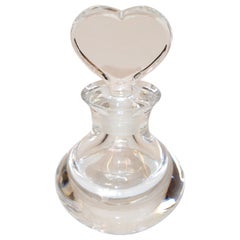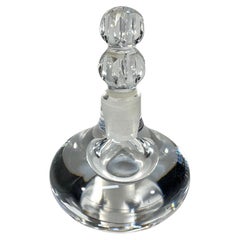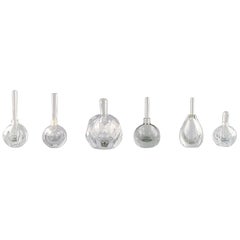Orrefors Perfume Bottle
Orrefors Sweden Thick Blown and Handmade Art Glass Perfume Bottle Heart Stopper
By Orrefors
Located in Miami, FL
Vintage clear signed Orrefors blown and handmade art glass perfume bottle with a heart shaped
Category
Late 20th Century Swedish Mid-Century Modern Bottles
Materials
Art Glass, Blown Glass
Fine Crystal Perfume Bottle With Faceted Stopper By Orrefors, Sweden. c1980's
By Orrefors
Located in Rothley, Leicestershire
Beautiful and pure, crystal clear perfume bottle by Orrefors, Sweden
Unusually faceted, cut crystal
Category
Mid-20th Century Swedish Scandinavian Modern Bottles
Materials
Crystal
$269 Sale Price
40% Off
H 3.5 in Dm 2.25 in
Recent Sales
Vicke Lindstrand for Kosta Boda & Edward Hald for Orrefors, Six Perfume Bottles
Located in København, Copenhagen
perfume bottles in clear art glass. Designed in the 1940s-1960s.
In very good condition.
Incised
Category
Vintage 1940s Swedish Art Deco Glass
Materials
Art Glass
People Also Browsed
Early 19th Century French Aubusson Floral Gouache Cartoon in Gilt Frame
By Aubusson Manufacture
Located in Dallas, TX
Add a touch of historic French charm with this elegant antique Aubusson drawing. Created in Aubusson, France circa 1820, this delicate gouache on paper features a hand-painted floral...
Category
Antique Early 19th Century French Louis XVI Decorative Art
Materials
Giltwood, Paper
$800
H 27.5 in W 15 in D 1.25 in
19th Century Coffret with Mother of Pearl
Located in Opole, PL
We present you a low wooden coffret, whose surface is covered with diamond-shaped mother of pearl tiles.
This item is from Q3 of the 19th century.
The mother of pearl is made of tw...
Category
Antique Late 19th Century European Decorative Boxes
Materials
Mother-of-Pearl, Velvet, Plastic
1950's Style Curved Velvet Sofa in Custom Velvet Colors
Located in NEW YORK, NY
The Sofa inspires itself nature where green is the predominant element and where valleys and hills prevail. The item’s details allow it to be the perfect statement piece for any cont...
Category
21st Century and Contemporary Portuguese Modern Sofas
Materials
Velvet, Walnut
$13,794 / item
H 33.08 in W 115.36 in D 61.82 in
Italian Frosted & Infused Gold Scavo Glass Urn Vase, Vessel Handles Italy 1980
By Murano 5
Located in Miami, FL
Frosted & infused Gold Scavo glass Murano Art glass urn vase, vessel, decanter Mid-Century Modern made in Italy in 1980.
Diameter of the opening is 9 inches.
The decorative Handles a...
Category
Vintage 1980s Italian Mid-Century Modern Vases
Materials
Murano Glass, Blown Glass
$750
H 12.75 in W 12 in D 9 in
Sterling Silver Art Nouveau Perfume Bottle
By Webster Company
Located in Brooklyn, NY
Being offered is a sterling silver and crystal perfume bottle from the Art Nouveau period. It has a deep-green glass with sterling overlay. The silver pattern is quintessential Art...
Category
Antique Early 1900s American Art Nouveau Sterling Silver
Materials
Crystal, Sterling Silver
Antique 19th Century French Ormolu Beveled Glass Trinket Box
Located in Pearland, TX
A gorgeous antique 19th Century French ormolu glass trinket box, circa 1860. This miniature box has the original tufted silk lining, thick beveled glass with floral etching, intricat...
Category
Antique 19th Century French Jewelry Boxes
Materials
Ormolu
Vintage Duck Table Lamp in Amber and Green Glass and Metal Bronze Dale Tiffany
By Dale Tiffany
Located in Bochum, NRW
Dale Tiffany Duck Lamp.
Beautiful and Unique Duck lamp made with amber and green glass.
A beautiful addition to any home decor.
Superb craftsmanship and techniques for producing th...
Category
1990s European Mid-Century Modern Table Lamps
Materials
Metal
$332 Sale Price
20% Off
H 5.91 in W 10.24 in D 5.12 in
French Art Deco Floral Lalique Perfume Bottle
Located in Queens, NY
French Art Deco round glass perfume bottle with decorative floral and scroll relief with a rust-colored staining (signed LALIQUE)
Category
20th Century French Art Deco Bottles
Materials
Glass
A Large Victorian Hand-Crafted Patinated Wire Frame Structural Bird Cage
Located in Reading, Berkshire
A Large Victorian Hand-Painted & Hand-Crafted Wire Frame Patinated Structural Decorative Bird Cage.
A decollate birdcage ideal for decorative purposes.
Category
Antique 19th Century British Victorian Bird Cages
Materials
Wire
$1,047
H 30.32 in W 15.75 in D 9.45 in
Exceptional Louis XVI Style Gilt Bronze and Malachite Grandfather Clock
Located in London, GB
Exceptional Louis XVI style gilt bronze and malachite grandfather clock
French, late 19th century
Measures: Height 250cm, width 54cm, depth 33cm
This superb longcase clock is a ...
Category
Antique Late 19th Century French Louis XVI Grandfather Clocks and Longca...
Materials
Malachite, Ormolu
$142,832 Sale Price
30% Off
H 98.43 in W 21.26 in D 13 in
Charles Zublena Fiberglass Pool Chaise Lounges, France
By Charles Zublena
Located in Brooklyn, NY
Charles Zublena designed, mod, fiberglass, poolside, chaise lounges manufactured by Les Plastiques de Bourgogne, France, 1960, marked underside “LP/Club 41 Salbris.” Depending on how...
Category
Vintage 1960s French Mid-Century Modern Patio and Garden Furniture
Materials
Fiberglass
Italian Venetian Grotto Seashell Settee
By Pauly et Cie
Located in Queens, NY
Italian Venetian Grotto (19th cent.) silver gilt settee with triple seashell seat and dolphin & seahorse motif (att: Pauly et Cie, Venice)
Category
Antique 19th Century Italian Romantic Settees
Materials
Silver Leaf
'Daffodil' Table Lamp by Tiffany Studios
By Tiffany Studios
Located in London, GB
‘Daffodil’ table lamp by Tiffany Studios
American, c. 1910
Height 56cm, diameter 40cm
Designed and hand-made by the artisans from the renowned Tiffany Studios (1902-1932), this ‘Daf...
Category
Early 20th Century American Art Nouveau Table Lamps
Materials
Bronze, Lead
Lalique Crystal Dahlia Perfume Bottle
By Lalique
Located in Philadelphia, PA
From Lalique, France, the iconic Dahlia Parfume bottle, circa early 1980s.
Black enameled accents highlight the Dahlia blossoms seen on both sides of the rounded front bottle.
Mold...
Category
Vintage 1980s French Art Nouveau Bottles
Materials
Crystal
Curved Art Deco Modern Vanity Set By Paul Poiret
By Paul Poiret
Located in North York, ON
This stunning Modern Art Deco Style curved vanity, designed by the iconic French designer Paul Poiret, is an impressive work of art perfect for any bedroom. The vanity features a lar...
Category
Vintage 1930s French Art Deco Vanities
Materials
Metal
$16,000 Sale Price
20% Off
H 43.5 in W 59.5 in D 34 in
World War II Military Campaign Steamer Trunk Owner Major McGregor Medical Corps
Located in Reading, Berkshire
A Well Preserved British World War II Military Campaign Steamer Trunk. Owner Major RM McGregor. Medical Corps
27 Bridge Street Hawick
At No 27 is the long-established Deans Chartere...
Category
Early 20th Century English Campaign Trunks and Luggage
Materials
Brass
$3,253 Sale Price
20% Off
H 48.04 in W 21.66 in D 25.6 in
Get Updated with New Arrivals
Save "Orrefors Perfume Bottle", and we’ll notify you when there are new listings in this category.
Orrefors Perfume Bottle For Sale on 1stDibs
With a vast inventory of beautiful furniture at 1stDibs, we’ve got just the orrefors perfume bottle you’re looking for. Frequently made of glass, art glass and metal, every orrefors perfume bottle was constructed with great care. You’ve searched high and low for the perfect orrefors perfume bottle — we have versions that date back to the 20th Century alongside those produced as recently as the 20th Century are available. A orrefors perfume bottle, designed in the Art Deco, Art Nouveau or mid-century modern style, is generally a popular piece of furniture. Charles Schneider and Orrefors each produced at least one beautiful orrefors perfume bottle that is worth considering.
How Much is a Orrefors Perfume Bottle?
The average selling price for a orrefors perfume bottle at 1stDibs is $12,450, while they’re typically $295 on the low end and $700,000 for the highest priced.
More Ways To Browse
1950s Perfume Bottles
Amber Empoli Vase
Antique Aqua Bottles
Antique Fish Bottles
Apothecary Jar Glass Green Gold
Blue Glass Vanity Set
Chinese Perfume Bottle
Figural Perfume Bottle
Filigrana Bottle
Galle Bottles
Gold Snuff Bottle
Julien Viard
Lalique Roger
Murano Glass Bottle Empoli
Ormolu Perfume Bottle
Pampaloni Decanter
Perfume Vial
Roman Glass Bottles


